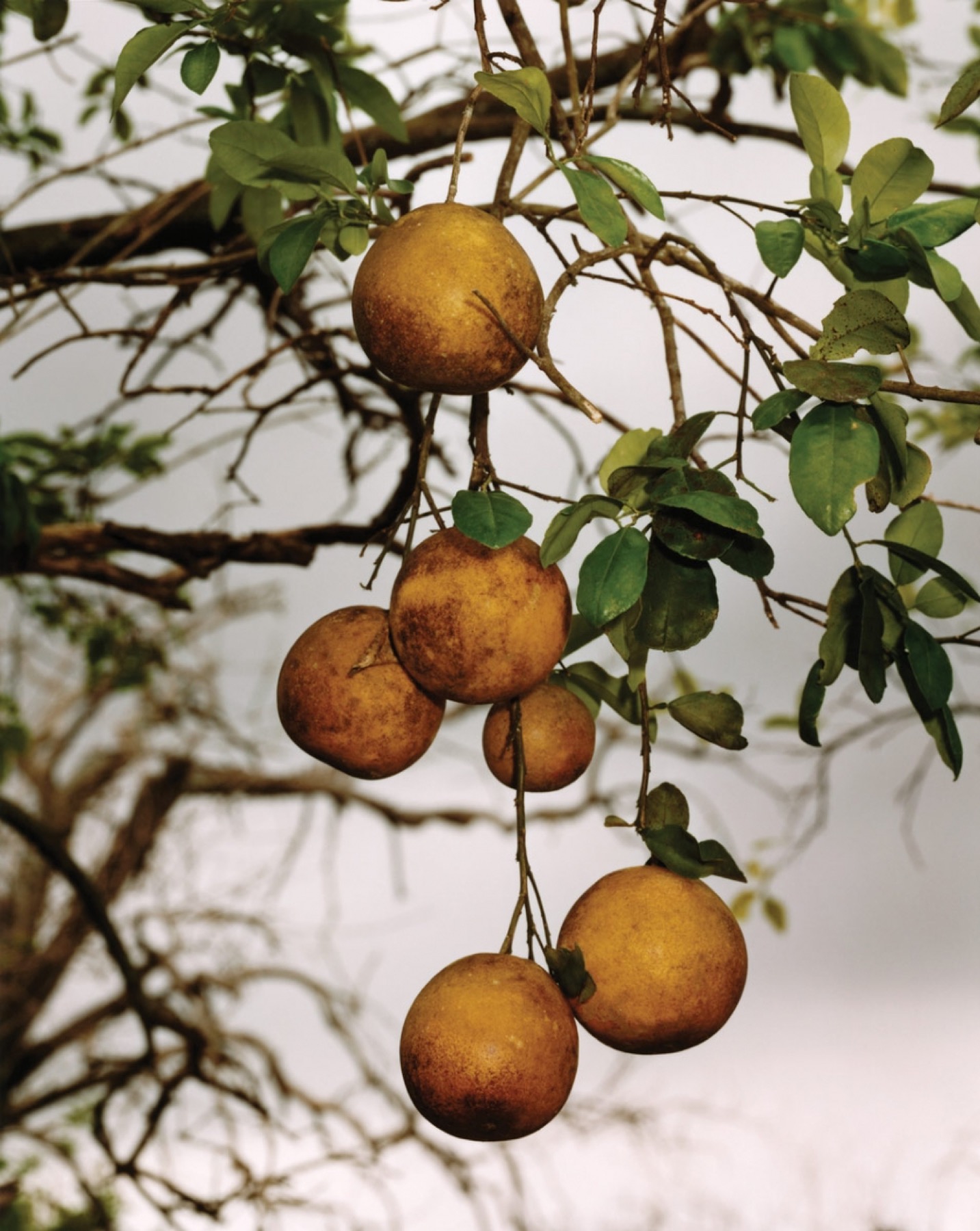Cara Cara Orange
By Aimee Nezhukumatathil

Roe Ethridge, Orange Grove #4, 2004. © Roe Ethridge. Courtesy Gagosian
Citrus sinensis
Are they ripe yet? This is the question my parents are most often asked since they moved to central Florida. Their neighbors, church friends, and daughters always wonder—it is a guaranteed source of conversation year-round. Within one year of moving from Ohio after my mom retired, my parents were the owners of three navel orange trees, which they had to petition their condo board to plant. And when they built a new house, they dug up and transplanted these three, adding seven more, as well as tangerine and pomelo trees. And just this last visit I found a lemon tree already swollen with fruit, growing as tall as my chin.
Cara cara navels are medium-sized oranges, their skin almost mottled and bruised just from exposure to the elements, and their flesh deep pink, darker than a grapefruit, and so sweet. What sets cara caras apart from other oranges, what makes me love them, is their cherry and rose petal smell, the kind you can almost taste after your first juicy bite. And when I visit my parents in central Florida, during winter and spring breaks, that’s when the cara cara peaks. In this liminal winter-into-spring time, orange dots weigh heavy in the branches along most highways. You can almost imagine someone is throwing orange confetti as you zoom past in your car. On our long twelve-hour road trips, I look for the glowing orbs along the side of the road in small Floridian towns. There they are: so many cara caras tucked under street curbs after falling out of orange-juice factory trucks.
My mother asks me to eat an orange after breakfast. After lunch. For a snack. For dessert. And I said yes to all of these requests, at first. Until I began to almost resent the orange, in the last vestiges of me being a bratty teenager. Sometimes I’d say no, just to say no. I wanted to eat an orange of my own volition. My own thought. It pained her when I asked for something different. Whay another fruit? We hab so many oranges. Your father and I picked them this morning just for you, for you!
When I got married, I knew she loved my husband, and I also knew she adored my in-laws because she would gift them these oranges, the most precious offerings of her and my father’s gardens. After my kids could finally eat solid foods, one of her greatest pleasures was hand-feeding them slices of fresh citrus—all the white threads lovingly pulled off for a sweet bite. Her grandsons would waddle over to her, clap their hands, sometimes even dance a jig in the middle of the kitchen—all before squawking and chirping for another bit of “onge.” See, she would tell me, your sons will be more healthy than you. Look how many slices they want! So tragic you only eat one today! And she’d turn back to her little citrus project, and happily mop up their shiny faces glimmered with juice, and laugh at their exuberance, at their jack-o’-lantern smiles caused by a new phase of missing teeth.
And now in these slow, winter days in Mississippi—when I ache for the laughter of my parents between semesters—the question of the cara cara comes back to me as I see stacks of other oranges scrubbed clean of any of the natural blemishes found in Florida groves. Are these ripe yet? Are these? How about this one? The citrus in the store looks impossible, like the pretend plastic fruit in the plastic basket that came with my sons’ toy grocery cart. I have no desire for fruit that bleached over and shiny.
How could I, after the aromatic rose and cherry taste of the cara cara? My sons don’t believe me when I say there was ever a time they couldn’t pronounce the word orange. They also can’t believe there was a time when they couldn’t pronounce the L in Florida: Fo-da! Foda! When they were small and I had to sternly remind them it was past their bedtime or forbid them from eating too many cookies, they used to tell me: No, no—I go to Foda! Foda—Florida—the place where grandparents let them eat just about anything they could fit in their little bellies. They can’t believe, now, that a grocery store might not sell cara caras. Let’s go back to Lola’s yard, my littlest one says as he steers the cart toward the checkout line. I can pick as many as I want, and she never gets mad!
Of course she doesn’t, I think to myself, as we place groceries on the moving belt. You and your brother are the very plump and sweet fruit she’d always hoped to one day squeeze. When daily news seems to bring forth another fresh grief—more children killed, the Amazon rainforest ablaze for weeks—I think of this orange, its sweetness and the smiles it brings to so many families. For the daily tragedies, I try to do what I can to help—donate money, gather bathroom supplies—but my heart longs for a place of tenderness. Where people offer each other, offer strangers, a fresh globe of fruit. Sure thing, sweetheart, I tell him as I hoist a melon on the counter. Let’s go back to Foda soon. We are all overdue for a visit.

